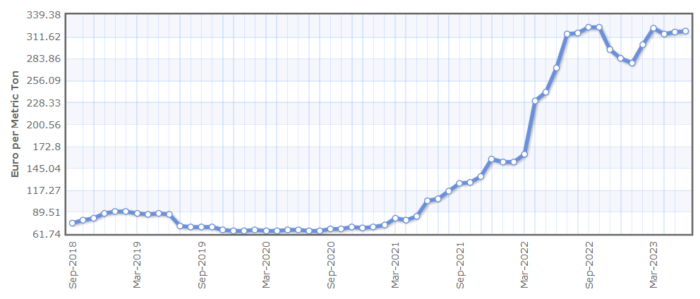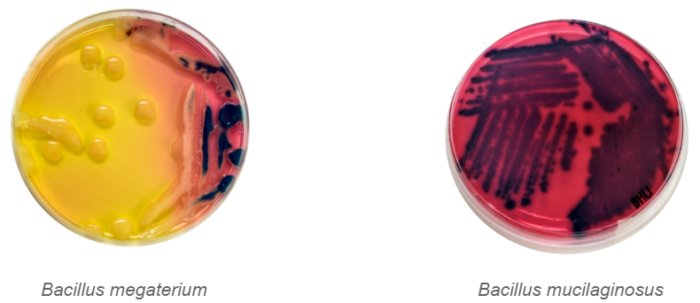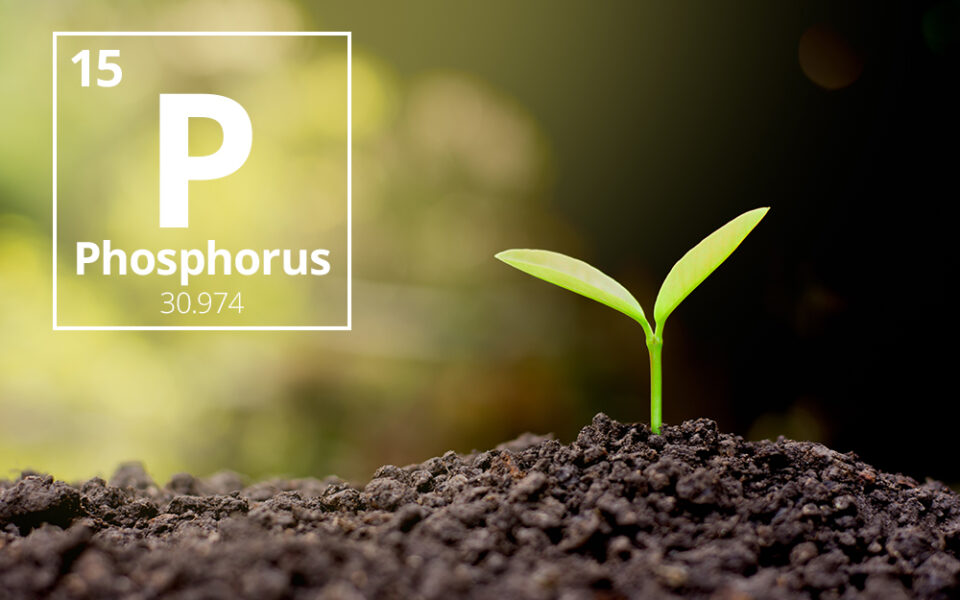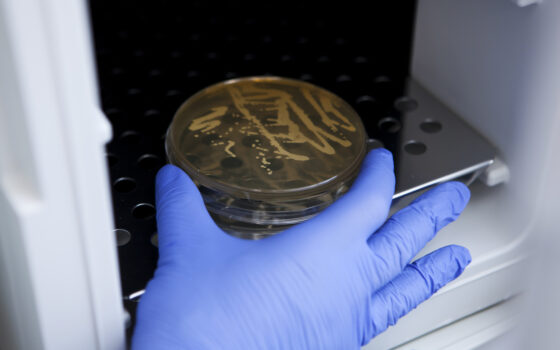It is often said that phosphorus is life. This element is one of the most important raw materials in the entire food production chain, from fertilization to the processed food industry. Today, almost all of the world’s industrial demand for phosphorus-based products is met exclusively using fossil phosphorus, whose natural resources are rapidly depleting. As much as 90% of the world’s fossil phosphorus is consumed in the agricultural industry – to produce fertilizers and feed. There is only one phosphate rock mine in Europe (Finland), which meets only 10% of the EU’s total demand.
Fossil phosphorus resources are rapidly depleting, and significant price fluctuations are observed in the market. The war in Ukraine is the latest factor reducing availability, supply tensions have also increased due to Russia’s ban on rock phosphate and phosphorus fertilizer exports, and similar restrictions on Chinese exports that are still in place.

It should be noted that this is neither the first nor the last phosphorus price crisis in recent decades. After the supply crisis of 2007, phosphorite (phosphate stone) prices increased by as much as 700% in just over a year, which led to a corresponding increase in fertilizer prices.
Phosphorus use in agriculture
Currently in agriculture, phosphorus is used inefficiently at many stages of its life cycle, resulting in groundwater pollution and wasted resources. The main causes of loss of usable phosphorus are soil erosion and leaching, as well as inefficient use of manure, biodegradable waste, and sewage. A flow analysis carried out in France shows that 50% of the total amount of phosphorus used in France is lost: about 20% with sewage, the same amount of phosphorus is lost through soil erosion and leaching, and 10% with food waste and other biological waste.
Paradoxically, although phosphorus reserves (in organic and inorganic form) found in the soil are very high, phosphorus, which is available to the plants, is relatively low. Unavailable to the plants phosphorus compounds are converted into their available (soluble) forms very slowly. Phosphorus by itself, as an element, is highly reactive, therefore it is not detected in its elemental form and immediately forms insoluble phosphates with metals: in acidic soil it combines with Al 3+, Fe 2+, Mn 2+, and in alkaline soil with Ca 2+.
Due to these properties of phosphorus, plants can only absorb 10-20% of P from the applied phosphorus fertilizers.
However, in nature, the soil microorganisms are using organic matter as a source of food and energy. During this process, the microorganisms break it down into mineral compounds which are easy to absorb by the plants. Microorganisms release organic acids (citric, gluconic, oxalic, etc.), and siderophores, which release phosphate ions from the mineral form. Organic phosphorus (phytates, phospholipids, nucleic acids) is mineralized into an inorganic form under the action of microorganism enzymes (phosphatases, phytases). Bacteria and fungi immobilize only part of the phosphorus for their own needs. The biomass of living organisms contains a lot of nitrogen, phosphorus, sulfur, and potassium. Microorganisms accumulate 17.4 kg of phosphorus in 1 ha of cultured soil. Once the microorganisms perish, the organic matter is mineralized by the living microorganisms, and the sorbed phosphorus becomes available to the plants.
Summary of the possibilities of phosphorus use in agriculture:
- Fossil phosphorus resources are rapidly depleting, which increases the prices of phosphorus fertilizers.
- The efficiency of applied phosphorus is low, plants absorb only up to 20% of it, and most of it is washed away and pollutes groundwater.
- Microorganisms existing in the soil and participating in the phosphorus mineralization-immobilization cycle are extremely important in ensuring phosphorus availability to the plants and the preservation of phosphorus in the biomass of microorganisms.
- Chemically polluted and degraded soils do not have a sufficient amount of beneficial microorganisms, they must be purposefully and as effectively as possible introduced into the soil, thereby increasing the absorption of already existing and additionally introduced phosphorus, reducing losses and pollution to nature.
To determine the efficiency of individual strains of microorganisms which are additionally introduced into the soil, increasing the availability of phosphorus to plants, in 2020 a collaboration between Nando and VDU agriculture academy doctorant Justinas Anušauskas was started. The purpose of it was to determine the effectiveness of separate, additionally into the soil inserted microorganisms, towards increasing phosphorus accessibility to the plants.
Joint long-term laboratory and field trials were conducted. Field trials were conducted with the application of NPK fertilizer to have the trials resemble conventional agricultural technology as closely as possible. Composite NPK fertilization is the most common form of phosphorus fertilization. Due to the slow absorption of phosphorus, the fertilizer is usually applied in the autumn period.

Laboratory trials
The laboratory trials aimed to precisely identify the effect on phosphorus solubilization by distinct microorganisms, hence the lab trials were conducted using monocultures while a complex of microorganisms – Nando BioSpektrum WG was applied in the field trials. The most commonly known strain in the scientific literature that solubilizes phosphorus is Bacillus megaterium, however, the Bacillus mucilaginosus bacteria used by Nando is also recognized to have sufficient capabilities in solubilizing insoluble substances.
After carrying out the trials, it was found that the capability of phosphorus solubilization under laboratory conditions of the latter strain is also very high.
The trial was run using a full NPK composition as well as a pure source of phosphorus (phosphorus powder – “FM” in the images below), and monostrains (Meg- B. megaterium; Mclg – B. mucilaginosus). Two main factors of phosphorus solubilization speed were evaluated – change in pH level and change in solubilized phosphorus. The change in pH level indicates microorganism-secreted acids that dissolve insoluble phosphorus compounds. The data analysis is presented as follows:
Laboratory trial conclusions
Both microorganism strains effectively performed phosphorus solubilization and secreted a high amount of phosphorus-solubilizing acids, especially in the solubilization of pure phosphorus (phosphorus powder);
Different microorganism strains were characterized by distinct mechanisms in providing the effect of solubilized phosphorus:
Bacillus Megaterium used and fixed a higher concentration of solubilized phosphorus in the living biomass of microorganisms;
Bacillus Mucilaginosus solubilized a higher concentration of phosphorus into an instantly plant-accessible form, fixing less of it in the living biomass of microorganisms.
Both strains of microorganisms are highly effective in reducing phosphorus losses and increasing their accessibility to plants while distinct effect mechanisms enable more consistent and long-term facilitation of plant growth.
Field trials
Field trials were conducted for three years in the Alytus region, Rauboniai village. During the trials, the product Nando BioSpektrum WG was used which contains microorganisms tested previously under laboratory conditions.
The fertilizer technology in the Control variant consisted of NPK 300 kg/ha + AN 200 kg/ha and was repeated in the Nando BioSpektrum WG variant – with the microbial product added.
During the 1st year analysis (the year 2020) of the barley grain harvest results, a 9.34 % harvest yield increase was observed with Nando microbial technology applied. However, the increase in straw mass was not as significant as for the grain, amounting to only 2.73%. This suggests that higher crop productivity does not induce straw mass growth and soil resource depletion.
The 2nd year of analogical trial results showed a 6.97% increase in harvest yield.
The final third year of trials (the year 2022) showcased by far the best results – a 17.24% increase in harvest yield.

It should be noted that the key focus of this trial was on the soil, in particular – phosphorus changes in the soil. An increase of solubilized and plant-accessible phosphorus of 55.6 % has been observed in 2021 with the application of the microbial product (MO), compared to conventional fertilizing.
Moreover, using the microbial product and only half of the composite fertilizer application rate produced the same increase of plant-accessible phosphorus as with a full fertilizer application rate and no microbial product.
During the three-year analysis period, a significant positive effect on the soil humus has been noted (+0.15% compared to standard technology). It has also been determined that the variants with the applied microbial product indicated a slight decrease in soil pH which reaffirms the previous laboratory trials – a significant activity in phosphorus solubilization can be measured not only in the amount of solubilized, accessible phosphorus but also in the acidity (observing the microorganism-secreted weak acids).
Conclusions:
- Natural phosphorus reserves are rapidly depleting while geopolitical tensions affecting its supply are only exacerbating the accessibility of the mineral. As a result, the current phosphate rock prices in the raw material markets are record-high.
- Phosphorus is prone to create insoluble compounds with metal ions, in turn making its accessibility to plants limited. Phosphorus-solubilizing microorganisms can partly solubilize it and make it more accessible to plants.
- B. megaterium and B. mucilaginosus are effective in solubilizing phosphorus compounds while secreting weak acids. During the process, a portion of phosphorus turns plant-accessible while a part is consolidated into the microorganism biomass.
- Phosphorus-solubilizing microorganisms present in Nando’s BioSpektrum WG not only allow for an increase in the harvest yield potential but also mitigate phosphorus deficiency to plants in case of reduced fertilizer application. Based on the trial results, it can also be derived that the microbial technology was able to substitute roughly 100 kg of NPK fertilizer while maintaining the same harvest yield.
- Lastly, long-term use of the microbial product positively affects the soil humus layer.





